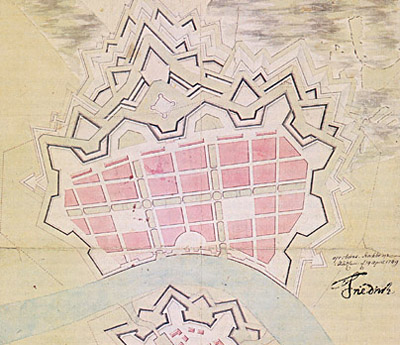| Landskrona

| | De skånske byer var små i forhold til de sjællandske. Men i 1749 blev der i Landskrona satset på en omfattende byplan. Den tog bl.a.udgangspunkt i et nyt militært befæstningsanlæg og betød nedrivning af en gotisk katedral med næsten samme størrelse som Lunds Domkirkes imponerende dimensioner.
Landskrona fik en stil efter 1700-talets ideal, men den totale visionen blev ikke virkeliggjort. |
Byerne - Landskrona
Ikke bare det skånske land var kommet bagud i udviklingen. Det samme gjaldt også de skånske byer. Man får et fingerpeg om byernes indbyrdes betydning som købstæder, fordi Linné nævner antallet af borgere (købmænd) i hver by. Malmö havde 350 stk., Lund 196, Landskrona 150, Helsingborg 130 og Ängelholm 70-80. Malmö var i 1750´erne den eneste by som Linné så som betydende.
Landskronas udvikling
I Landskrona beundrede Linné den store og smukke kirke. ”som nu skulle formindskes til fordel for det nye fæstningsværk”. Man havde ved denne tid opfrisket idéen om at videreudvikle Landskrona. Linné beskrev dette foretagende i sin Rejse i Skåne:
”… nu bygges stengader ud i selve havet på den sydvestlige og vestlige side. Mellem disse skal kvarterene fyldes op og bebygges og byen funderes, så at skibene kan fortøje ved kaj langs med husene i en sikker havn. Dette er et værk som ligner Herculis og som ikke af andre end konger og potentater kan efterlignes.”

Landskronas byplan 1749 | 
Landskronas befæstning | 
Borgmesterhuset i Landskrona |
Ny byplan
Den svenske rigsdag havde i 1747 besluttet at byen igen skulle befæstes med et nyt stærkt citadel på den lille ø Gråen ud for Landskrona. Fra denne ø skulle et befæstningsværk beskytte havnen og den nye by, som skulle bygges syd for den gamle. I 1749 havde Fredrik I godkendt den nye byplan, som denne gang havde en rektangulær form.
Eftersom man byggede store dele af byen udenfor strandlinien skulle et system af kanaler dræne området. Kanalerne byggedes efter hollandsk forbillede, da man anlagde en gade mellem husene og kanalen, ligesom i Nyhavn i København. Slotsarkitekten Carl Hårleman fra Stockholm prægede udformningen af bygningerne.
Kirken skiftes
Hårleman var også manden bag den nye kirke, som påbegyndtes i 1754 men indviedes dog først i 1788. Kirken fik navnet Sofia Albertina efter Gustav 3.s søster.
Den gamle gotiske kirke, som var næsten lige så stor som Lunds domkirke, blev nedrevet. Man mente, at kirken lå for tæt på den gamle fæstning, og man var bange for at en fjende kunne okkupere kirken og derfra beskyde fæstningen. Desuden var kirken forfalden og indeholdt masser af bygningsmateriale, som kunne bruges til nye projekter. Både strategiske og økonomiske årsager lå bag nedrivningen af en af Nordens pragtfuldeste gotiske kirker.

Den gamle kirke i Landskrona | 
Den nye kirke i Landskrona | 
Den nye kirke i Landskrona |
Projektet stoppes
Arbejdet med det nye Landskrona trak ud og blev samtidigt alt for dyrt. Da Sveriges finanser blev anstrengte under krigen mod Rusland i 1788, nedlagdes projektet, og den nye by blev kun halvt fuldendt. Til trods for at planerne ikke fuldførtes fik Landskrona et tydeligt 1700-talspræg, og i dag finder man adskillige bygninger fra den tid, da man prøvede at skabe en ny moderne by i tidens ånd. |